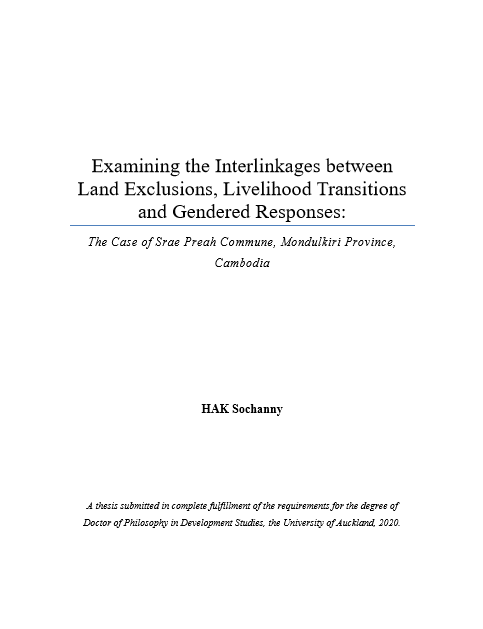
This thesis examines the interactions of land exclusions with livelihood transitions, and subsequent gendered responses in both material and emotional forms. It uses a theoretical framework that includes powers of exclusion, livelihood transitions, adaptation and resistance and emotional political ecology to argue that there are many ways to understand the relationships between power and practice in the escalating process of land grabbing. Rather than relying on a universal narrative, this research identifies different configurations of power. The empirical material was generated from the author's long-standing research relationship with the Bunong people in Srae Preah commune, Mondulkiri Province, Cambodia. The study employs a mixed-methods approach that combines quantitative household surveys over time, as well as qualitative methods comprising in-depth interviews, life stories, wealth-ranking exercises, and participant observations. Findings show that land exclusions induced by conservation and economic land concessions were evident and enabled by the powers of informality, regulation, the market and force, which limited villagers' customary resource rights. Also, the communal land titling program, which was intended to be inclusive and equitable, resulted in an "intimate exclusion" by community elites. This inequality was exacerbated by capitalist relations that transformed indigenous people's livelihoods into resource commodification leading to market dependency. These transitions resulted in reduced livelihood choices and a greater reliance on the commodity market for household income, although there was still a desire to protect traditional livelihoods. This meant prosperity and impoverishment co-existed, as depicted in the rise in overall income but also in income inequality. Further, gender disparities in access to resources and gendered divisions of labor were evident. Community responses over time included adaptation but also a range of resistance strategies (institutional and non-institutional, direct and indirect, and overt and covert), depending on the reactions of the encroaching actors, their exclusionary powers, local leadership and historical experience. The resistance movements, albeit externally supported and unfederated, yielded some results, although the future of the resources at stake remained uncertain. A variety of both institutional and non-institutional approaches that engaged both men and women were more successful. Importantly, the affective emotions, particularly related to trauma and iii sensationalism, of the local leadership influenced and united villagers in their collective struggles.